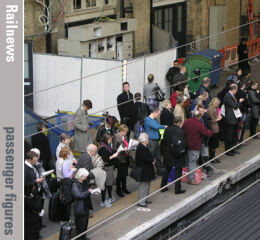Posted 21st March 2024 | 1 Comment
Passenger totals rise again

Updated 12.50
The Office of Rail and Road has revealed that 417 million passenger journeys were made on National Rail during the last three months of 2023, which was an increase of 20 per cent when compared with the same quarter a year earlier.
The total for 2023 was 1,570 million, which again showed a 20 per cent increase compared with 2022. Passenger kilometres rose by the same percentage, to 15.2 billion between October and December.
Revenue was also up, from £2.2 billion in the last quarter of 2022 to £2.6 billion in the same quarter last year.
The increases have been recorded in spite of seven days of industrial action in the last three months of 2023, which could mean falls in ‘trains planned’ of as much as 68 per cent on the worst affected days.
The ORR pointed out that the figures are also affected by split ticketing, which increases the number of individual journeys, and also by the fact that the statistics count each train used by a passenger, so that if a change of train is needed another journey is added to the total.
The private sector lobby group Rail Partners said: 'Although the latest ORR data shows an increase in passenger numbers, passengers are still not using trains at the levels seen before the pandemic.
‘This underlines the urgent need for rail reform to create a new public body to oversee the railways, but also to give operators the commercial freedoms to attract customers back to rail.’
The chief executive of the Railway Industry Association Darren Caplan said: ‘The return to rail continues apace and this substantial 20 per cent uplift year-on-year is a really encouraging increase in the number of passenger journeys and revenues.
‘This follows the excellent recent DfT passenger statistics which – despite changing calculations methodologies to exclude all Elizabeth Line passengers – have in March exceeded 100 per cent of pre-Covid figures. Inclusion of those passengers would take overall numbers to nearly 110 per cent, which is real progress considering the comparison year, 2019-20, was the second highest on record.
‘These new ORR and DfT figures are a reminder that the railway will need more capacity in the future, especially with the recent RIA-commissioned Steer report forecasting passenger numbers to grow between 37 per cent and 97 per cent to 2050, depending on which policy the Government adopts in the coming years.’
Reader Comments:
Views expressed in submitted comments are that of the author, and not necessarily shared by Railnews.

Christopher Jones-Bridger, Buckley Flintshire
Very encouraging especially against a backdrop where continuing industrial action has had an effect. Then again with more flexible working regular commuters have been able to adapt to the days when services have been affected while leisure travels have either rescheduled journeys or deferred their plans altogether.
Given the change in travel patterns as confidence has returned post lockdowns what really needs to be addressed is the yield. That requires the commercial managers who are closest to their individual markets to be given the freedom to market the product. It is also time to resolve the long standing industrial relations issues that have plagued the industry post covid. As I've commented before the staff are the employees of the individual operators. Time that negotiations over pay and terms & conditions are taken out of the hands of the umbrella body the RDG and dictatorial oversight by government ministers.
Also the recovery in demand continues to undermine the arguments of the Prime Minister & his Transport Ministers regarding a structural shift in transport demand that was used to undermine the case for HS2. What we've seen is a cynical shift in government funding from a serious long term rail investment project to literally backfill the long term neglect in the roads maintenance budget best illustrated by the plague of potholes.